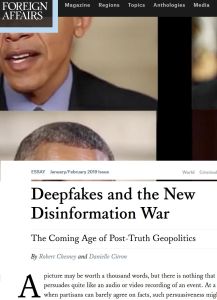Join getAbstract to access the summary!

Join getAbstract to access the summary!
Robert Chesney and Danielle Citron
Deepfakes and the New Disinformation War
The Coming Age of Post-Truth Geopolitics
Foreign Affairs, 2019
What's inside?
A fake image tells a thousand lies.
Recommendation
People in democratic societies today are worried about the rapid spread of fake news across social media – and rightly so, argue law experts Robert Chesney and Danielle Citron. In this essay for Foreign Affairs, Chesney and Citron warn about the danger of emerging technologies that will soon allow virtually anyone with a computer and internet access to create “deepfakes”: doctored visual and audio content which can help create false naratives and support other nefarious activities. Their eye-opening essay will be of interest to media consumers, public activists and policy makers.
Summary
About the Authors
Robert Chesney is Chair and Director of the Robert Strauss Center for International Security and Law at the University of Texas at Austin. Danielle Citron is Professor of Law at the University of Maryland.

















Comment on this summary